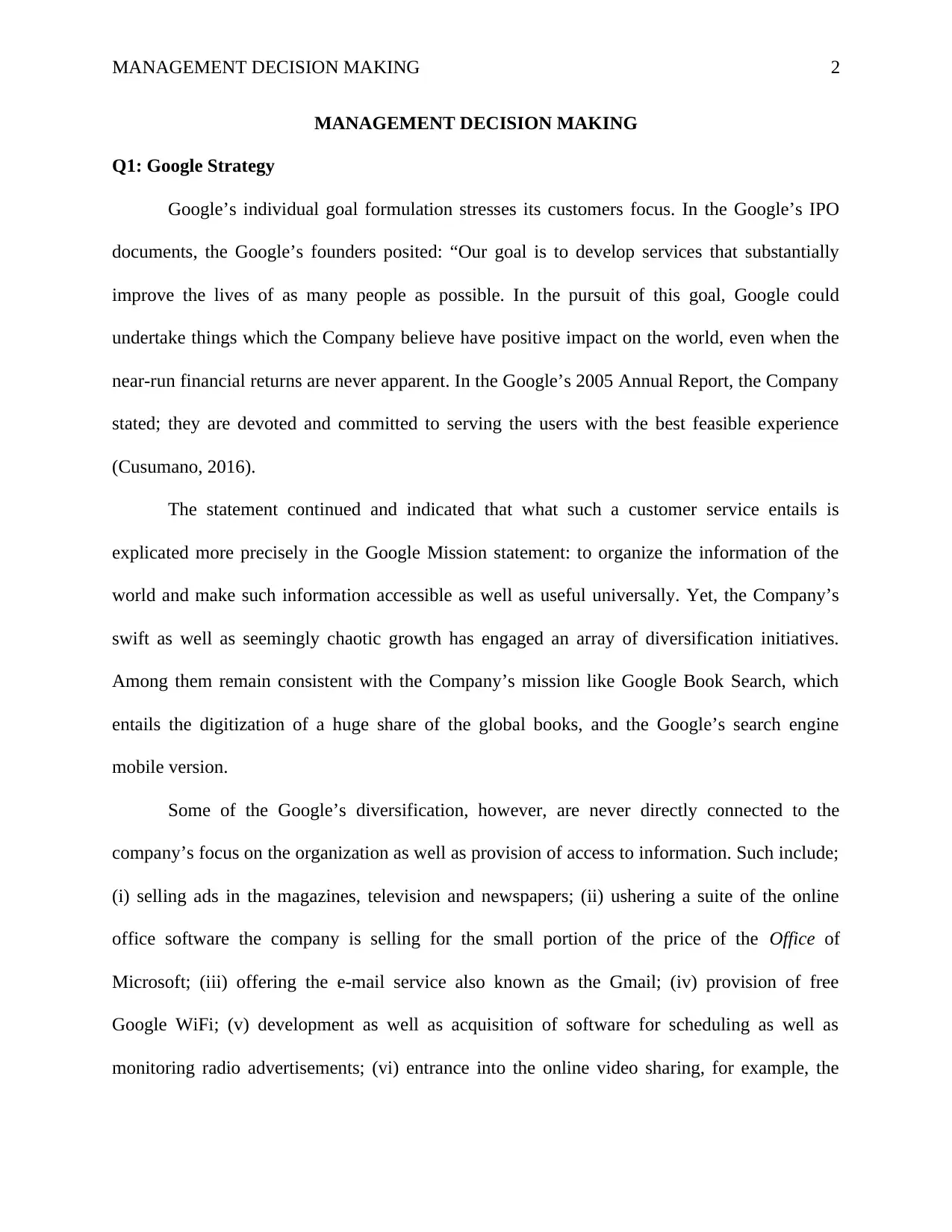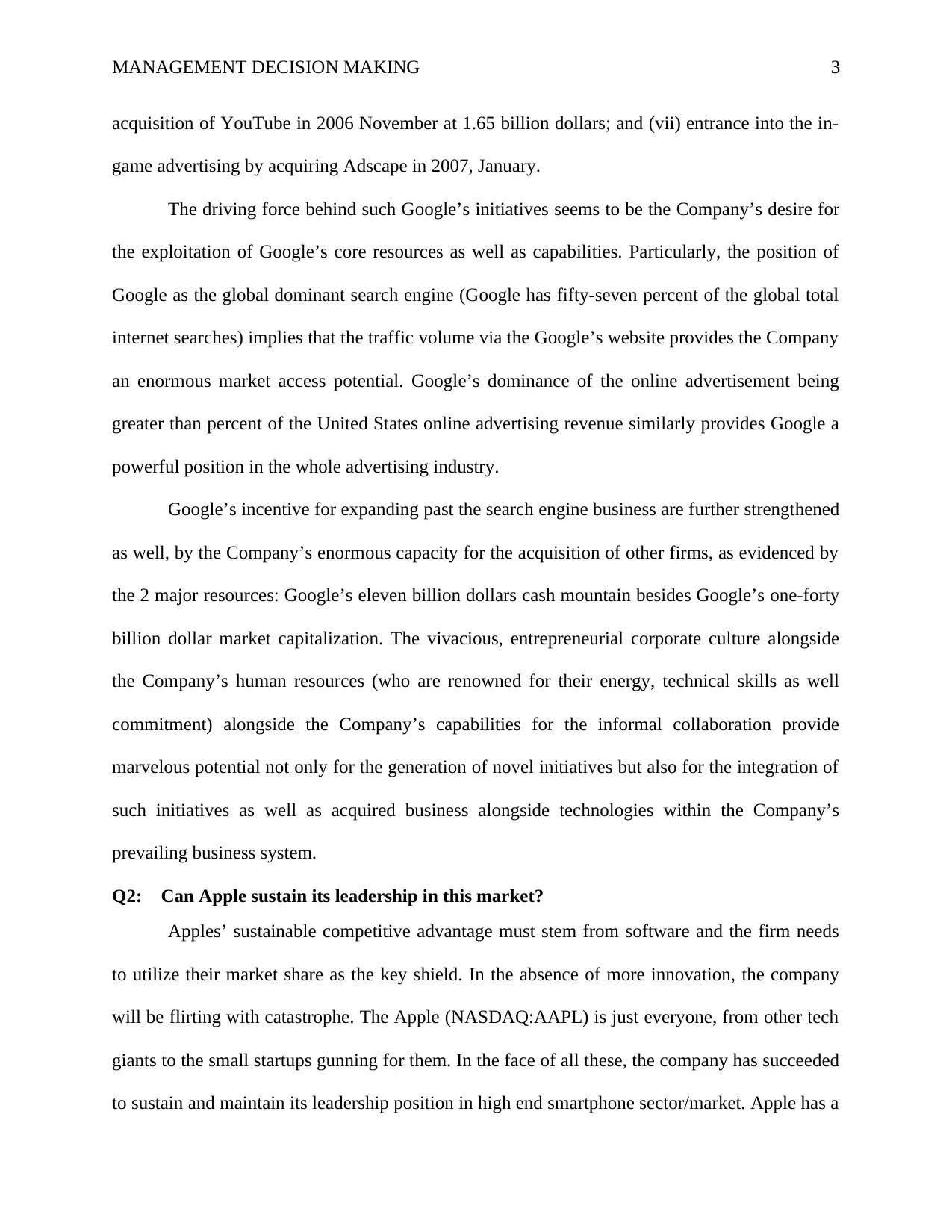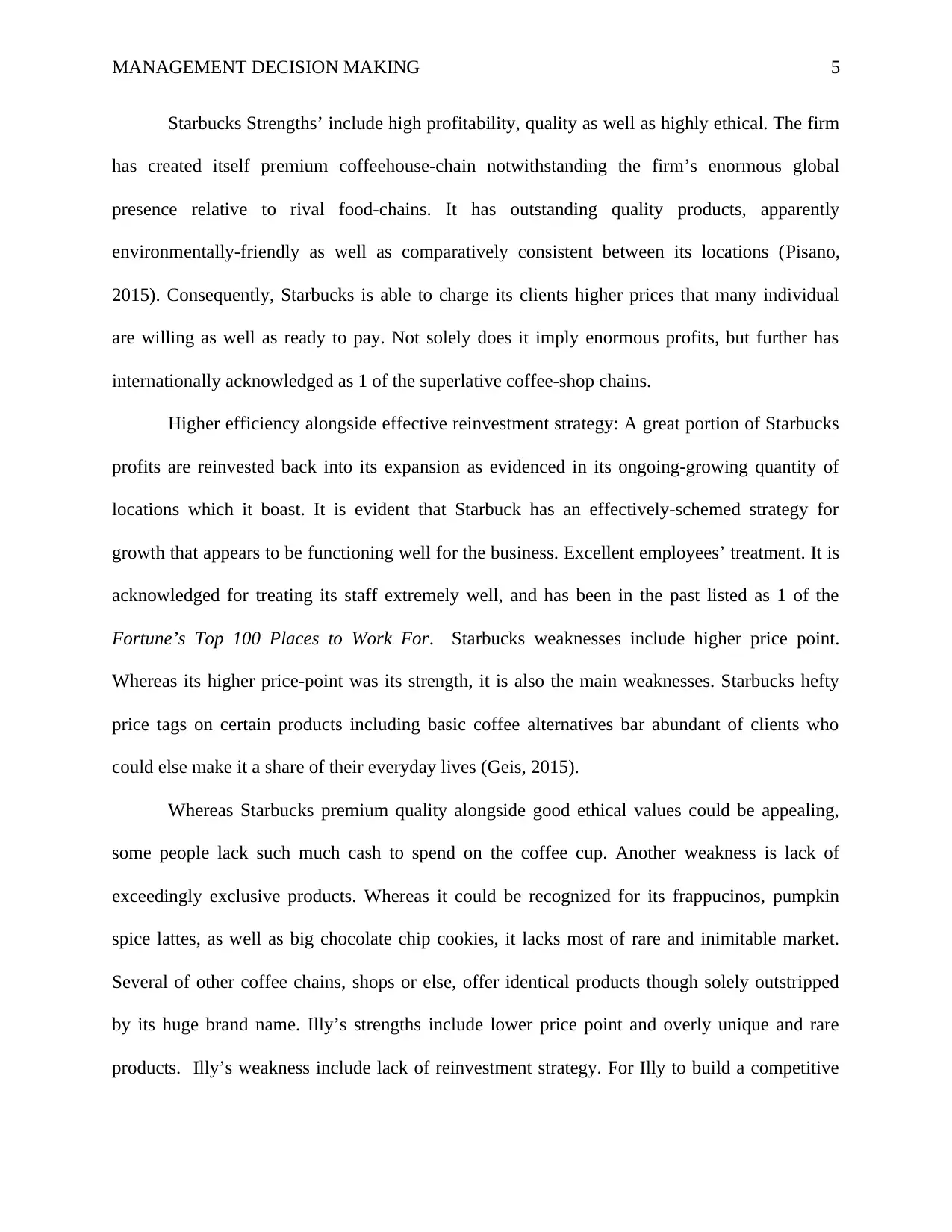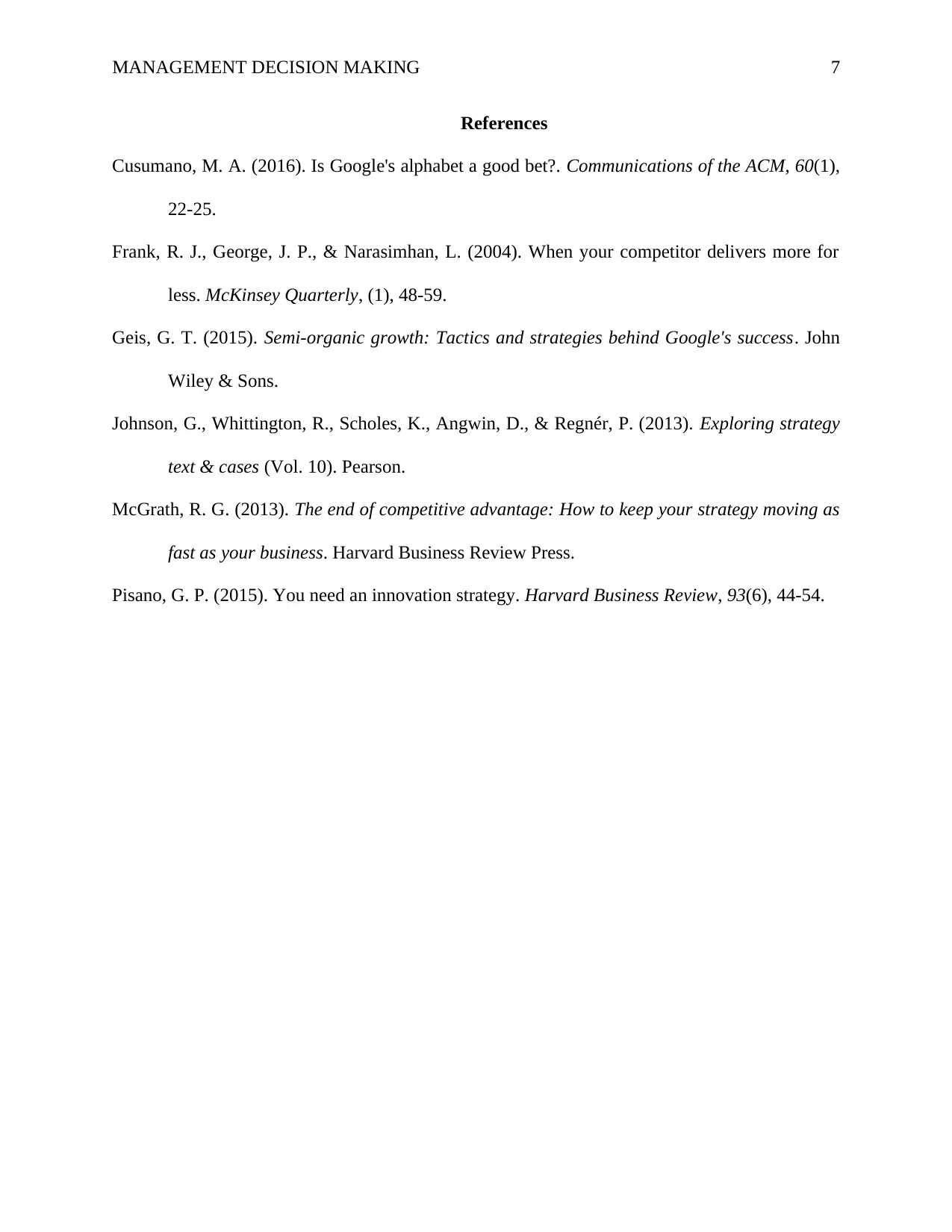Management Decision Making Report: Google, Apple, Illy, and Cheap Chic
VerifiedAdded on 2020/05/11
|7
|1882
|123
Report
AI Summary
This report delves into the management decision-making processes of several companies, offering insights into their strategic approaches. The analysis begins with Google, examining its goal formulation, diversification initiatives, and the driving forces behind its expansion, including its dominance in search and advertising. Next, the report assesses Apple's ability to sustain its leadership in the high-end smartphone market, focusing on its software, ecosystem, and the challenges it faces in maintaining its competitive advantage. The report then evaluates Starbucks' strengths and weaknesses, considering its profitability, quality, and ethical practices, alongside its higher price point and product exclusivity. Finally, the report explores the challenges of designing and implementing a cheap chic strategy, using examples from IKEA, Target, H&M, and Zara, and proposes strategies for a novel restaurant chain.

Running head: MANAGEMENT DECISION MAKING 1
Management Decision Making
Name
Institution
Management Decision Making
Name
Institution
Paraphrase This Document
Need a fresh take? Get an instant paraphrase of this document with our AI Paraphraser

MANAGEMENT DECISION MAKING 2
MANAGEMENT DECISION MAKING
Q1: Google Strategy
Google’s individual goal formulation stresses its customers focus. In the Google’s IPO
documents, the Google’s founders posited: “Our goal is to develop services that substantially
improve the lives of as many people as possible. In the pursuit of this goal, Google could
undertake things which the Company believe have positive impact on the world, even when the
near-run financial returns are never apparent. In the Google’s 2005 Annual Report, the Company
stated; they are devoted and committed to serving the users with the best feasible experience
(Cusumano, 2016).
The statement continued and indicated that what such a customer service entails is
explicated more precisely in the Google Mission statement: to organize the information of the
world and make such information accessible as well as useful universally. Yet, the Company’s
swift as well as seemingly chaotic growth has engaged an array of diversification initiatives.
Among them remain consistent with the Company’s mission like Google Book Search, which
entails the digitization of a huge share of the global books, and the Google’s search engine
mobile version.
Some of the Google’s diversification, however, are never directly connected to the
company’s focus on the organization as well as provision of access to information. Such include;
(i) selling ads in the magazines, television and newspapers; (ii) ushering a suite of the online
office software the company is selling for the small portion of the price of the Office of
Microsoft; (iii) offering the e-mail service also known as the Gmail; (iv) provision of free
Google WiFi; (v) development as well as acquisition of software for scheduling as well as
monitoring radio advertisements; (vi) entrance into the online video sharing, for example, the
MANAGEMENT DECISION MAKING
Q1: Google Strategy
Google’s individual goal formulation stresses its customers focus. In the Google’s IPO
documents, the Google’s founders posited: “Our goal is to develop services that substantially
improve the lives of as many people as possible. In the pursuit of this goal, Google could
undertake things which the Company believe have positive impact on the world, even when the
near-run financial returns are never apparent. In the Google’s 2005 Annual Report, the Company
stated; they are devoted and committed to serving the users with the best feasible experience
(Cusumano, 2016).
The statement continued and indicated that what such a customer service entails is
explicated more precisely in the Google Mission statement: to organize the information of the
world and make such information accessible as well as useful universally. Yet, the Company’s
swift as well as seemingly chaotic growth has engaged an array of diversification initiatives.
Among them remain consistent with the Company’s mission like Google Book Search, which
entails the digitization of a huge share of the global books, and the Google’s search engine
mobile version.
Some of the Google’s diversification, however, are never directly connected to the
company’s focus on the organization as well as provision of access to information. Such include;
(i) selling ads in the magazines, television and newspapers; (ii) ushering a suite of the online
office software the company is selling for the small portion of the price of the Office of
Microsoft; (iii) offering the e-mail service also known as the Gmail; (iv) provision of free
Google WiFi; (v) development as well as acquisition of software for scheduling as well as
monitoring radio advertisements; (vi) entrance into the online video sharing, for example, the

MANAGEMENT DECISION MAKING 3
acquisition of YouTube in 2006 November at 1.65 billion dollars; and (vii) entrance into the in-
game advertising by acquiring Adscape in 2007, January.
The driving force behind such Google’s initiatives seems to be the Company’s desire for
the exploitation of Google’s core resources as well as capabilities. Particularly, the position of
Google as the global dominant search engine (Google has fifty-seven percent of the global total
internet searches) implies that the traffic volume via the Google’s website provides the Company
an enormous market access potential. Google’s dominance of the online advertisement being
greater than percent of the United States online advertising revenue similarly provides Google a
powerful position in the whole advertising industry.
Google’s incentive for expanding past the search engine business are further strengthened
as well, by the Company’s enormous capacity for the acquisition of other firms, as evidenced by
the 2 major resources: Google’s eleven billion dollars cash mountain besides Google’s one-forty
billion dollar market capitalization. The vivacious, entrepreneurial corporate culture alongside
the Company’s human resources (who are renowned for their energy, technical skills as well
commitment) alongside the Company’s capabilities for the informal collaboration provide
marvelous potential not only for the generation of novel initiatives but also for the integration of
such initiatives as well as acquired business alongside technologies within the Company’s
prevailing business system.
Q2: Can Apple sustain its leadership in this market?
Apples’ sustainable competitive advantage must stem from software and the firm needs
to utilize their market share as the key shield. In the absence of more innovation, the company
will be flirting with catastrophe. The Apple (NASDAQ:AAPL) is just everyone, from other tech
giants to the small startups gunning for them. In the face of all these, the company has succeeded
to sustain and maintain its leadership position in high end smartphone sector/market. Apple has a
acquisition of YouTube in 2006 November at 1.65 billion dollars; and (vii) entrance into the in-
game advertising by acquiring Adscape in 2007, January.
The driving force behind such Google’s initiatives seems to be the Company’s desire for
the exploitation of Google’s core resources as well as capabilities. Particularly, the position of
Google as the global dominant search engine (Google has fifty-seven percent of the global total
internet searches) implies that the traffic volume via the Google’s website provides the Company
an enormous market access potential. Google’s dominance of the online advertisement being
greater than percent of the United States online advertising revenue similarly provides Google a
powerful position in the whole advertising industry.
Google’s incentive for expanding past the search engine business are further strengthened
as well, by the Company’s enormous capacity for the acquisition of other firms, as evidenced by
the 2 major resources: Google’s eleven billion dollars cash mountain besides Google’s one-forty
billion dollar market capitalization. The vivacious, entrepreneurial corporate culture alongside
the Company’s human resources (who are renowned for their energy, technical skills as well
commitment) alongside the Company’s capabilities for the informal collaboration provide
marvelous potential not only for the generation of novel initiatives but also for the integration of
such initiatives as well as acquired business alongside technologies within the Company’s
prevailing business system.
Q2: Can Apple sustain its leadership in this market?
Apples’ sustainable competitive advantage must stem from software and the firm needs
to utilize their market share as the key shield. In the absence of more innovation, the company
will be flirting with catastrophe. The Apple (NASDAQ:AAPL) is just everyone, from other tech
giants to the small startups gunning for them. In the face of all these, the company has succeeded
to sustain and maintain its leadership position in high end smartphone sector/market. Apple has a
⊘ This is a preview!⊘
Do you want full access?
Subscribe today to unlock all pages.

Trusted by 1+ million students worldwide

MANAGEMENT DECISION MAKING 4
huge margins, huge loyal base as well as generate enormous quantities of hype with each release
of smartphone.
Hardware matters so little to Apple’s long term success, and hence Apple’s software is
the core to Apple maintaining leadership. Apple has for a long time established an insular,
differentiated ecosystem as well as a stronger brand of quality. These together have culminated
in Apple’s competitive advantage, however, these are already being washed away. Maintaining
Apple’s competitive advantage will remain its key to keeping its leadership position in the high-
end smartphone market (McGrath, 2013). At the moment using the VRIO (Valuable, Rare,
Imitable and Organize to Value) method points towards Apple’s sustainable competitive
advantage. The value of Apple is unhidden and its rarity lies on its software design, its high cot
to imitate emerges from its network effect, software design and brand and Apple’s evidence that
it is organized to capture value lies on its income statement.
The firm’s future sustainable is questioned as its sustainable competitive advantage it has
enjoyed since the iPhone’s launch is fast eroding. Nevertheless, Research and Development
expenses have surged by four billion over the previous two years, hence it is good that Apple is
working on something (Johnson, Whittington, Scholes, Angwin & Regnér, 2013). Unless Apple
does something substantial with IOS 11 release, it will be opening itself up to Google and
Samsung to assume market share. The future value of Apple seems not look like it has space for
moving upwards. Apple investment appears increasingly risky due to the stiff competition and
Apple’s innovation uncertainty alongside high valuation. Apple needs to prove its ability to
innovate without Steve Jobs at its helm.
Q3. Advising Illy
huge margins, huge loyal base as well as generate enormous quantities of hype with each release
of smartphone.
Hardware matters so little to Apple’s long term success, and hence Apple’s software is
the core to Apple maintaining leadership. Apple has for a long time established an insular,
differentiated ecosystem as well as a stronger brand of quality. These together have culminated
in Apple’s competitive advantage, however, these are already being washed away. Maintaining
Apple’s competitive advantage will remain its key to keeping its leadership position in the high-
end smartphone market (McGrath, 2013). At the moment using the VRIO (Valuable, Rare,
Imitable and Organize to Value) method points towards Apple’s sustainable competitive
advantage. The value of Apple is unhidden and its rarity lies on its software design, its high cot
to imitate emerges from its network effect, software design and brand and Apple’s evidence that
it is organized to capture value lies on its income statement.
The firm’s future sustainable is questioned as its sustainable competitive advantage it has
enjoyed since the iPhone’s launch is fast eroding. Nevertheless, Research and Development
expenses have surged by four billion over the previous two years, hence it is good that Apple is
working on something (Johnson, Whittington, Scholes, Angwin & Regnér, 2013). Unless Apple
does something substantial with IOS 11 release, it will be opening itself up to Google and
Samsung to assume market share. The future value of Apple seems not look like it has space for
moving upwards. Apple investment appears increasingly risky due to the stiff competition and
Apple’s innovation uncertainty alongside high valuation. Apple needs to prove its ability to
innovate without Steve Jobs at its helm.
Q3. Advising Illy
Paraphrase This Document
Need a fresh take? Get an instant paraphrase of this document with our AI Paraphraser

MANAGEMENT DECISION MAKING 5
Starbucks Strengths’ include high profitability, quality as well as highly ethical. The firm
has created itself premium coffeehouse-chain notwithstanding the firm’s enormous global
presence relative to rival food-chains. It has outstanding quality products, apparently
environmentally-friendly as well as comparatively consistent between its locations (Pisano,
2015). Consequently, Starbucks is able to charge its clients higher prices that many individual
are willing as well as ready to pay. Not solely does it imply enormous profits, but further has
internationally acknowledged as 1 of the superlative coffee-shop chains.
Higher efficiency alongside effective reinvestment strategy: A great portion of Starbucks
profits are reinvested back into its expansion as evidenced in its ongoing-growing quantity of
locations which it boast. It is evident that Starbuck has an effectively-schemed strategy for
growth that appears to be functioning well for the business. Excellent employees’ treatment. It is
acknowledged for treating its staff extremely well, and has been in the past listed as 1 of the
Fortune’s Top 100 Places to Work For. Starbucks weaknesses include higher price point.
Whereas its higher price-point was its strength, it is also the main weaknesses. Starbucks hefty
price tags on certain products including basic coffee alternatives bar abundant of clients who
could else make it a share of their everyday lives (Geis, 2015).
Whereas Starbucks premium quality alongside good ethical values could be appealing,
some people lack such much cash to spend on the coffee cup. Another weakness is lack of
exceedingly exclusive products. Whereas it could be recognized for its frappucinos, pumpkin
spice lattes, as well as big chocolate chip cookies, it lacks most of rare and inimitable market.
Several of other coffee chains, shops or else, offer identical products though solely outstripped
by its huge brand name. Illy’s strengths include lower price point and overly unique and rare
products. Illy’s weakness include lack of reinvestment strategy. For Illy to build a competitive
Starbucks Strengths’ include high profitability, quality as well as highly ethical. The firm
has created itself premium coffeehouse-chain notwithstanding the firm’s enormous global
presence relative to rival food-chains. It has outstanding quality products, apparently
environmentally-friendly as well as comparatively consistent between its locations (Pisano,
2015). Consequently, Starbucks is able to charge its clients higher prices that many individual
are willing as well as ready to pay. Not solely does it imply enormous profits, but further has
internationally acknowledged as 1 of the superlative coffee-shop chains.
Higher efficiency alongside effective reinvestment strategy: A great portion of Starbucks
profits are reinvested back into its expansion as evidenced in its ongoing-growing quantity of
locations which it boast. It is evident that Starbuck has an effectively-schemed strategy for
growth that appears to be functioning well for the business. Excellent employees’ treatment. It is
acknowledged for treating its staff extremely well, and has been in the past listed as 1 of the
Fortune’s Top 100 Places to Work For. Starbucks weaknesses include higher price point.
Whereas its higher price-point was its strength, it is also the main weaknesses. Starbucks hefty
price tags on certain products including basic coffee alternatives bar abundant of clients who
could else make it a share of their everyday lives (Geis, 2015).
Whereas Starbucks premium quality alongside good ethical values could be appealing,
some people lack such much cash to spend on the coffee cup. Another weakness is lack of
exceedingly exclusive products. Whereas it could be recognized for its frappucinos, pumpkin
spice lattes, as well as big chocolate chip cookies, it lacks most of rare and inimitable market.
Several of other coffee chains, shops or else, offer identical products though solely outstripped
by its huge brand name. Illy’s strengths include lower price point and overly unique and rare
products. Illy’s weakness include lack of reinvestment strategy. For Illy to build a competitive

MANAGEMENT DECISION MAKING 6
advantage it should maximize on the Starbucks weaknesses and turn them into its strengths and
use Starbucks strengths to strengthen its weaknesses.
Q4. Principal challenges of cheap chic strategy design and implementation
Merging low cost with differentiation advantage remains an appealing mixture for any
firm. The challenge, however, is pulling it off. Differentiation characteristically adds cost-in
enhanced design, variety, quality as well as additional attributes. Hence, for the cheap chic
strategy to work there is a need for differentiation gains to compensate the extra cost engaged.
For IKEA, TARGET, H&M and Zara among other successful exponents of this strategy, the core
is to uphold a basic model of a low-cost operator yet to add a few of distinguishing features of
increased upscale operators. Nevertheless, reconciling stylishness alongside low cost might be
challenging (Frank, George & Narasimhan, 2004). It needs reconciling scale with pace and
nimbleness. It calls for fast-cycle design, production alongside distribution, as well as alertness
to market trends are required in fashion retailing. Major retailers like Wal-Mart ad Sears lack
systems which allow such pace alongside responsiveness.
Designing a Cheap Chic Strategy
For a novel restaurant chain, a cheap chick approach might engage a range of strategies:
A McDonald’s kind fast-food operation which encompassed an increasingly higher standards of
the cuisine. The restaurants with the ambiance as well as décor linked with increased upscale
restaurants but with a degree of turnover as well as standardized menu which allowed low cost of
the operation like the UK’s Pizza Express.
advantage it should maximize on the Starbucks weaknesses and turn them into its strengths and
use Starbucks strengths to strengthen its weaknesses.
Q4. Principal challenges of cheap chic strategy design and implementation
Merging low cost with differentiation advantage remains an appealing mixture for any
firm. The challenge, however, is pulling it off. Differentiation characteristically adds cost-in
enhanced design, variety, quality as well as additional attributes. Hence, for the cheap chic
strategy to work there is a need for differentiation gains to compensate the extra cost engaged.
For IKEA, TARGET, H&M and Zara among other successful exponents of this strategy, the core
is to uphold a basic model of a low-cost operator yet to add a few of distinguishing features of
increased upscale operators. Nevertheless, reconciling stylishness alongside low cost might be
challenging (Frank, George & Narasimhan, 2004). It needs reconciling scale with pace and
nimbleness. It calls for fast-cycle design, production alongside distribution, as well as alertness
to market trends are required in fashion retailing. Major retailers like Wal-Mart ad Sears lack
systems which allow such pace alongside responsiveness.
Designing a Cheap Chic Strategy
For a novel restaurant chain, a cheap chick approach might engage a range of strategies:
A McDonald’s kind fast-food operation which encompassed an increasingly higher standards of
the cuisine. The restaurants with the ambiance as well as décor linked with increased upscale
restaurants but with a degree of turnover as well as standardized menu which allowed low cost of
the operation like the UK’s Pizza Express.
⊘ This is a preview!⊘
Do you want full access?
Subscribe today to unlock all pages.

Trusted by 1+ million students worldwide

MANAGEMENT DECISION MAKING 7
References
Cusumano, M. A. (2016). Is Google's alphabet a good bet?. Communications of the ACM, 60(1),
22-25.
Frank, R. J., George, J. P., & Narasimhan, L. (2004). When your competitor delivers more for
less. McKinsey Quarterly, (1), 48-59.
Geis, G. T. (2015). Semi-organic growth: Tactics and strategies behind Google's success. John
Wiley & Sons.
Johnson, G., Whittington, R., Scholes, K., Angwin, D., & Regnér, P. (2013). Exploring strategy
text & cases (Vol. 10). Pearson.
McGrath, R. G. (2013). The end of competitive advantage: How to keep your strategy moving as
fast as your business. Harvard Business Review Press.
Pisano, G. P. (2015). You need an innovation strategy. Harvard Business Review, 93(6), 44-54.
References
Cusumano, M. A. (2016). Is Google's alphabet a good bet?. Communications of the ACM, 60(1),
22-25.
Frank, R. J., George, J. P., & Narasimhan, L. (2004). When your competitor delivers more for
less. McKinsey Quarterly, (1), 48-59.
Geis, G. T. (2015). Semi-organic growth: Tactics and strategies behind Google's success. John
Wiley & Sons.
Johnson, G., Whittington, R., Scholes, K., Angwin, D., & Regnér, P. (2013). Exploring strategy
text & cases (Vol. 10). Pearson.
McGrath, R. G. (2013). The end of competitive advantage: How to keep your strategy moving as
fast as your business. Harvard Business Review Press.
Pisano, G. P. (2015). You need an innovation strategy. Harvard Business Review, 93(6), 44-54.
1 out of 7
Related Documents
Your All-in-One AI-Powered Toolkit for Academic Success.
+13062052269
info@desklib.com
Available 24*7 on WhatsApp / Email
![[object Object]](/_next/static/media/star-bottom.7253800d.svg)
Unlock your academic potential
Copyright © 2020–2025 A2Z Services. All Rights Reserved. Developed and managed by ZUCOL.





